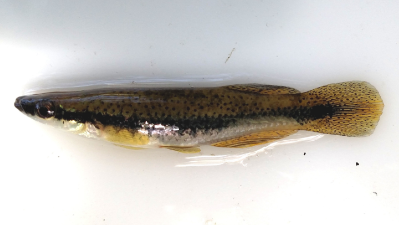
|
Blackspotted topminnow
Fundulus olivaceus
The blackspotted topminnow is common in shallow backwaters and small streams throughout Arkansas and the lower Mississippi river drainage. Its maximum length is about 3.5 to 4 inches and it feeds on both terrestrial and aquatic insects, small crustaceans and other small organisms. Blackspotted topminnows typically don't persist in ponds for long without replenishment by inflow from upstream wetlands. Blackspotted topminnows are forage for larger predator fish.
|
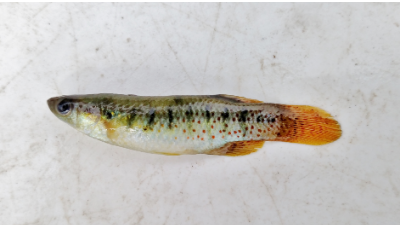
|
Golden topminnow
Fundulus chrysotus
Golden topminnows are found in parts of southeastern Arkansas, Louisiana and along the gulf coast into Florida inhabiting swamps, vegetated backwaters and small to medium-sized streams. Their maximum length is about 3.5 inches and they feed on both terrestrial and aquatic insects, small crustaceans and other small organisms. This small attractive fish will usually only persist in ponds that have dense vegetation and inflows from vegetated wetlands to replenish their numbers. Golden topminnows are forage for larger predator fish.
|
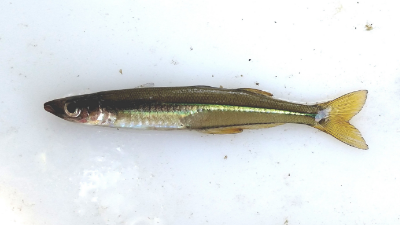
|
Brook silverside
Labidesthes sicculus
The brook silverside is common near the surface of large lakes, ponds and calm pools of flowing streams throughout the entire Mississippi river drainage and the southeastern USA. Its maximum length is around 5 inches and it feeds primarily on zooplankton. Brook silversides are forage for larger predator fish.
|
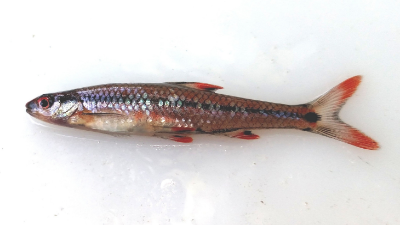
|
Taillight shiner
Notropis maculatus
The taillight shiner is usually found in vegetated backwaters of small to large rivers and ponds in the lower Mississippi river drainage and the southeastern USA. Its maximum length is around 3 inches and it feeds on zooplankton, some planktonic algaes and some insect larvae. The taillight shiner is one of many small wetland fish that would provide forage for larger predator fish.
|
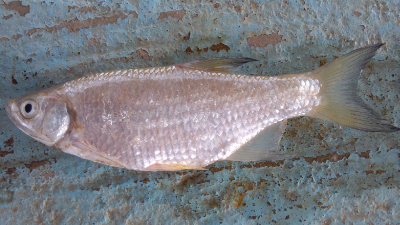
|
Golden shiner
Notemigonus crysoleucas
Golden shiners are widely sold as live-bait in fishing tackle stores, but they are also often stocked into ponds as supplemental forage fish. They eat a variety of small foods, including some fish eggs, but they feed principally on zooplankton. Golden shiners can grow to over 10 inches in length but they are usually less than 6 inches. They can spawn multiple times during the spring with their adhesive eggs sticking to aquatic vegetation. Despite this, golden shiners are highly susceptible to largemouth bass predation; so much so that they are usually eradicated from ponds with healthy largemouth bass populations. Therefore, they are usually only recommended when ponds are newly built or renovated to give largemouth bass forage options other than the newly-established bluegill, or as a supplemental forage option in established ponds where the largemouth bass are not growing well.
|
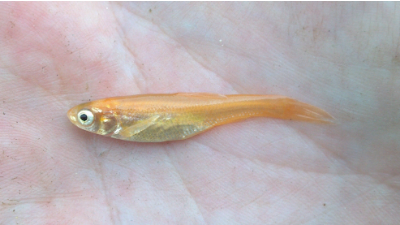
|
Fathead minnow
Pimephales promelas
Fathead minnows are widely sold as live-bait in fishing tackle stores, but they are also often stocked into newly-built or renovated ponds as a small forage option for newly-stocked fingerling largemouth bass. Fathead minnows are quite small, usually less than 3 inches in length, so their utility as a forage fish for adult largemouth bass is limited. Fathead minnows normally have dark olive backs fading to silvery bellies, but color varieties such as the "rosy-red" (pictured) have been developed as a flashy option for live-bait anglers. Despite their ability to spawn multiple times during the spring, fathead minnows are usually eliminated from ponds where healthy largemouth bass populations exist.
|
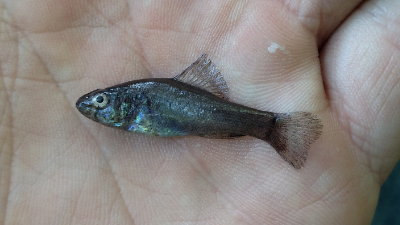
|
Pirate perch
Aphredoderus sayanus
Pirate perch are small, usually less than 4 to 5 inch, backwater swamp-dwelling fish that typically eat aquatic insects and small invertebrates. The most peculiar aspect of pirate perch is that the anus of the adults is located between the gills on the throat. Pirate perch are a rare inhabitant of fishing ponds and they have little to no impact on the pond fish communities they inhabit.
|
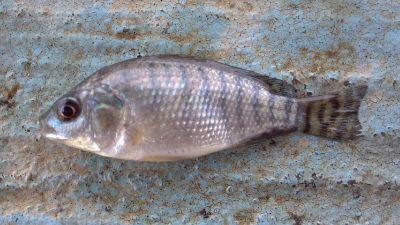
|
Tilapia
Oreochromis spp.
Tilapia are native to Africa but they have been introduced worldwide principally for human consumption. They have since become one of the most economically important fish in the world. Tilapia have some capacity to control the nuisance aquatic plant, filamentous algae, but their utility is limited by their susceptibility to cold. Tilapia become sluggish in water below 55 degrees Fahrenheit and they die below 50 degrees Fahrenheit. Therefore, they must be restocked each spring. Tilapia are sometimes stocked as a supplemental forage fish in ponds where trophy largemouth bass is the primary goal. Due to their frequent reproduction throughout the summer, tilapia can produce large amounts of forage in a relatively short amount of time. Tilapia should only be stocked into ponds where their escape is highly unlikely because they have the potential to be quite invasive and harmful to local aquatic communities.
|
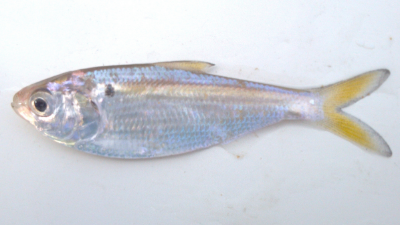
|
Threadfin shad
Dorosoma petenense
Threadfin shad are open-water schooling filter-feeders commonly 4 to 6 inches in length that eat primarily planktonic algae. They are an excellent food source for largemouth bass and they are occasionally stocked into ponds for that purpose. However, threadfin are susceptible to cold and begin to die when water drops below 45 degrees Fahrenheit. For this reason, it can be difficult to keep threadfin shad alive for more than a year in Arkansas ponds, especially in northern parts of the state.
|
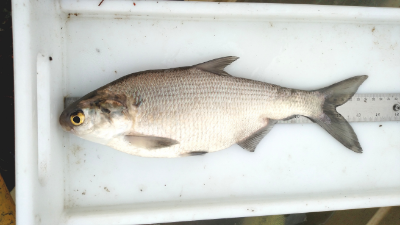
|
Gizzard shad
Dorosoma cepedianum
Gizzard shad are open-water schooling filter-feeders that look very similar to threadfin shad. Gizzard shad's mouths are located slightly below the tip of their snout while threadfin shad's mouths are located right at the tip of their snouts. Gizzard shad also grow much larger than threadfin, commonly reaching lengths in excess of 10 to 12 inches. Gizzard shad are not as cold-sensitive as threadfin and they usually survive even the coldest Arkansas winters. Gizzard shad are usually a risky proposition for fishing ponds because they tend to stockpile at sizes too large for largemouth bass to eat. This can result in a total collapse of the fishery because the high abundance of gizzard shad can consume large quantities of plankton which make up the base of the pond food chain. For this reason, gizzard shad are considered a species to avoid in the typical fishing pond.
|
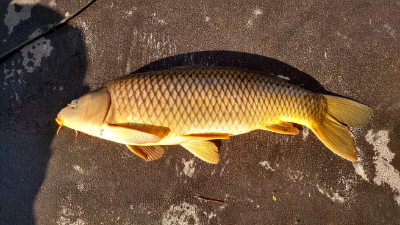
|
Common carp
Cyprinus carpio
Common carp are moderate to large, commonly over 12 inch, bottom-grazing fish that feed on a variety of small bottom-dwelling organisms and organic matter. They are common in vegetated backwaters and slow moving or stagnant systems with soft muddy bottoms. One of the most conspicuous identifying features of common carp is the pair of small barbels (whiskers) on either side of their fleshy sucker mouth. Common carp are considered a major nuisance for ponds because their feeding behavior causes muddy water which can reduce pond productivity and aesthetics. Common carp are also very difficult to remove and resistant to piscicides. In most cases the only way to effectively remove common carp populations from a pond is to drain the pond completely and start over.
|
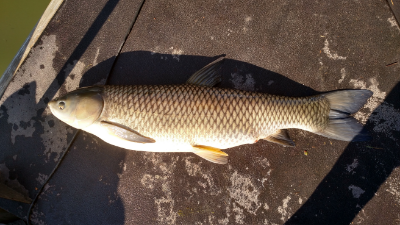 |
Grass carp
Ctenopharyngodon idella
Grass carp are native to Asia but they have been introduced worldwide for human consumption and for their ability to control certain nuisance aquatic plants. In North America, they are stocked primarily to control the invasive aquatic plant hydrilla principally, but also certain species of naiad and pondweed, fanwort, egeria, elodia chara, and bladderwort. Grass carp can grow to over 4 feet in length in certain situations. Grass carp require flowing water and firm sand/gravel stream bottoms for their eggs to survive and hatch. For this reason, some states, Arkansas included, consider fertile diploid grass carp safe to stock into ponds because they are not likely to reproduce. Still, most states require only sterile triploid grass carp be stocked. As a result, the majority of grass carp produced in local fish farms are triploid. Grass carp can be used as a vegetation prevention method, or as a tool to fix existing vegetation problems.
|
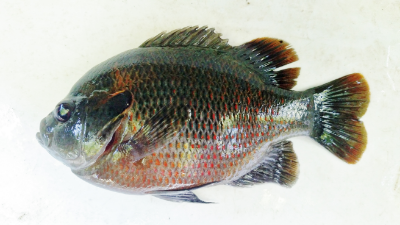
|
Redspotted sunfish
Lepomis miniatus
Redspotted sunfish are a less-common and fairly small, up to about 8 inch, relative to bluegill that inhabit heavily vegetated and slow-moving backwaters and impoundments. Redspotted sunfish are identified by rows of bright reddish/orange spots (on males) or yellowish/brown spots (on females) and a pale to reddish/orange patch just above the opercular (gill cover) flap. Redspotted sunfish primarily eat insects and aquatic invertebrates that live among aquatic plants and on the bottom. Redpotted sunfish are not a prolific species and they are unlikely to have much impact on the pond fish communities they live within.
|
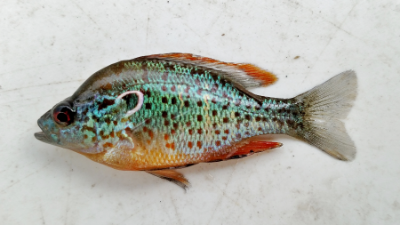
|
Orangespotted sunfish
Lepomis humilis
Orangespotted sunfish are found throughout Arkansas inhabiting pools of small to large streams, ponds and lakes. Their diet consists primarily of insect larvae and small crustaceans. While they are one of the less common and small sunfish in Arkansas, usually only reaching about 6 inches in length, orangespotted sunfish are one of the most brilliantly colored fish in the state. Orangespotted sunfish populations are usually very small and don't contribute or subtract much from fishing pond communities other than a pleasant surprise for anglers targeting small sunfish.
|
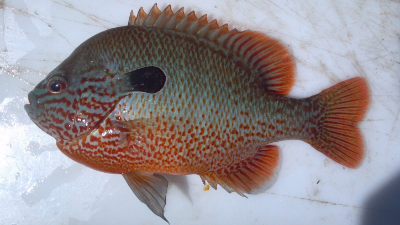
|
Longear sunfish
Lepomis megalotis
Longear sunfish, as the name suggests, have longer dark "ear" flaps on their operculum (gill cover) than most other species of sunfish that is lined with a thin white margin. They are brilliantly colored with wavy blue lines along their cheeks and operculum, bright orange bellies mottled with bright blue and bright orange to red fins. The longear sunfish is not a common pond species, it is usually found in rocky to sandy habitats near vegetation in small to medium-sized streams and impoundments. Their low abundance in the ponds they live in usually has little to no impact on the fish community.
|
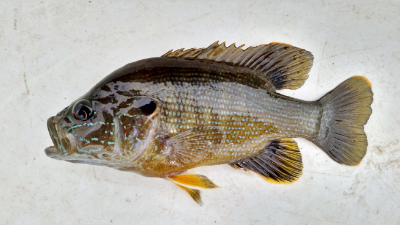
|
Green sunfish
Lepomis cyanellus
Green sunfish often inhabit the same areas as bluegill and their body shapes are similar. Green sunfish can be identified by the presence of white or orange tips to their fins, a much larger mouth than bluegill, and bright light-blue streaks running down their cheeks. Green sunfish can reach 10 inches or more, but they usually compete with both bluegill and largemouth bass for habitat and food, earning them a reputation as a pest. Green sunfish should be avoided in fishing ponds if possible.
|
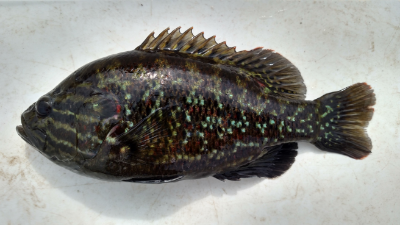
|
Bantam sunfish
Lepomis symmetricus
Bantam sunfish are found in the lower Mississippi River drainage, in parts of southeastern Arkansas, inhabiting heavily vegetated backwaters, ponds and lakes eating insects, insect larvae and small crustaceans. They are also small, usually only reaching 3 to 4 inches in length. Bantam sunfish are rare inhabitants of typical fishing ponds and they have little impact on the fish communities they live in.
|
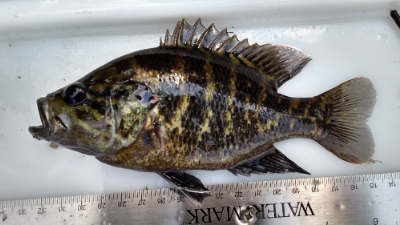
|
Warmouth
Lepomis gulosus
Warmouth are an independent species in the same family of fishes (Centrarchidae) as bluegill and largemouth bass, not a hybrid of the two as some believe. They can reach 10 to 12 inches in length but are usually much smaller. They are common in heavily vegetated environments feeding primarily on invertebrates and small fish. Warmouth can be fun to catch and they are aggressive. However, their diet puts them in competition with both bluegill and largemouth bass at different life stages so they are generally considered a detriment to the typical fishing pond community.
|
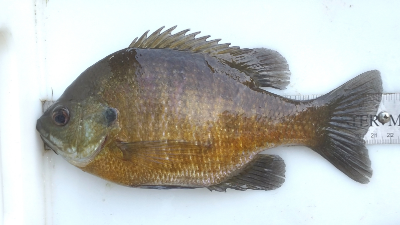
|
Bluegill
Lepomis macrochirus
Bluegill are easily identified by the dark blue/black flap on the upper back edge of their operculum (gill cover). They are one of the most common fish in Arkansas ponds, eating primarily insects, aquatic invertebrates and very small fish. Bluegill spawn many times during the summer, leading to very large populations very quickly if they are not controlled by predators. They are often the primary forage of largemouth bass and they are also very entertaining to fish for. While they are usually considered largemouth bass food, bluegill can serve as the main sportfish in ponds. Shifting the fish community towards an overabundance of small largemouth bass and a low population of bluegill supported by fertile water and fish feed can produce massive bluegill in excess of 12 inches in length that are highly entertaining to catch. Stocking genetically superior bluegill strains and utilizing specialized selective harvest techniques can push them to even larger sizes. Bluegill are a fascinatingly flexible species in ponds.
|
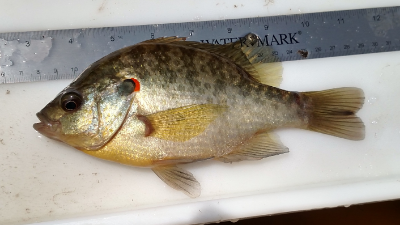
|
Redear sunfish
Lepomis microlophus
Redear sunfish can be identified by the red-orange outside edge of the dark flap on their operculum (gill cover). Redear can get larger than the typical bluegill but they also are usually not as abundant due to lower reproductive rates. Redear have the nickname "shell cracker" because of their habit of eating snails and other shelled invertebrates. This is beneficial in fishing ponds because snails are intermediate hosts of yellow grubs, a parasite that can infest the muscles of sportfish and render their fillets quite unappetizing. Ponds with healthy populations of redear sunfish rarely have problems with grubs. Redear can be caught by rod and reel but they tend to be more difficult to catch than bluegill.
|
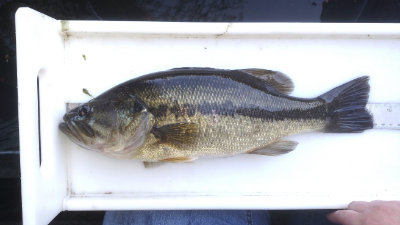
|
Largemouth bass
Micropterus salmoides
Largemouth bass are large predator fish, and one of the most popular sportfish in North America. They are commonly larger than 12 inches in length and can grow to well over 25 inches in length. They are easily identified by their massive mouth relative to their body size, and a dark blotchy band running horizontally along the midline of the body. The aggressively feed on virtually any fish, amphibian, mammal, or invertebrate that will fit into their mouths. Largemouth bass are usually the primary sportfish in fishing ponds but they can be used as a population control tool to allow for trophy bluegills and successful crappie fisheries, usually at the cost of largemouth bass size/quality. Because of their popularity, there are several varieties of largemouth bass available at sportfish farms, with each variety offering a blend of aggression, growth potential, and climate tolerance that owners can match to their goals and location.
|

|
Hybrid striped bass
Morone spp.
Hybrid striped bass are a cross between white bass and striped bass. They can be identified apart from their parent species by their irregularly broken dark horizontal bars running along their shiny silvery sides. Hybrid striped bass are an aggressive open-water predator that is sometimes stocked into ponds as an alternative sportfish, or as a tool to control shad or crappie populations. While hybrid striped bass habitat preferences are somewhat different from largemouth bass, their diets overlap substantially. Additionally, hybrid striped bass tend to perform poorly in water with low alkalinity and hardness. Therefore, owners should ensure that the forage base and water chemistry of their ponds are appropriate before introducing hybrid striped bass. While hybrid striped bass are fertile, they usually do not reproduce enough to maintain their populations in ponds.
|
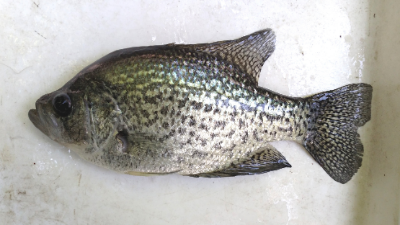
|
Black crappie
Pomoxis nigromaculatus
Crappie are one of Arkansas most popular sportfish but they tend to be difficult to manage in ponds. Crappie reproduction is unpredictable in ponds and when they do spawn they can produce so many offspring that the population becomes stunted from a shortage of food. Black crappie tend to perform better than white crappie in ponds because their reproduction is slightly more stable and their preferred died is more in-line with what is naturally available in a pond environment, but even black crappie are not easy to manage. Black crappie are similar in appearance to white crappie, but black crappie typically have dark blotches evenly spread across their sides and they have 7 or 8 dorsal fin spines. Crappie perform well more consistently in ponds larger than 25 acres and in ponds that are managed to have abundant largemouth bass populations. Another option is sterile crappie but they are a relatively new development that hasn't been fully researched and their availability is currently limited.
|
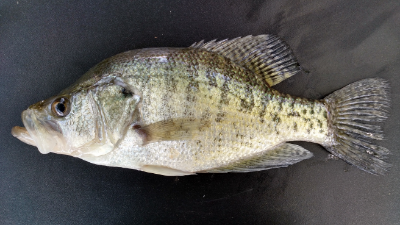
|
White crappie
Pomoxis annularis
White crappie tend to perform poorly in ponds because their reproduction is sporadic and they prefer eating minnows and shad that are less common in ponds than in larger reservoirs and rivers. White crappie have vertical dark bars along their sides and 6 dorsal fin spines. Crappie perform well more consistently in ponds larger than 25 acres and in ponds that are managed to have abundant largemouth bass populations. Another option is sterile crappie but they are a relatively new development that hasn't been fully researched and their availability is currently limited.
|
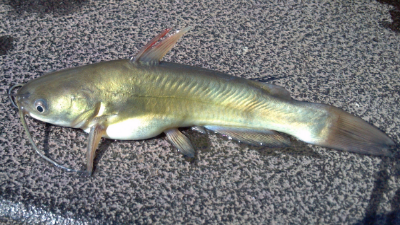
|
Channel catfish
Ictalurus punctatus
Channel catfish are one of the most well-known North American fish for their numerous barbels (whiskers), scaleless bodies, and the croaking sounds they can make with their serrated pectoral fin spines. Channel catfish are ideal pond fish because they are very tolerant of high temperature, high stocking rates, poor water chemistry, low dissolved oxygen, and muddy water. In many cases, if a pond is too small or it's water is too poor for the typical bluegill/largemouth bass strategies to work, channel catfish can still perform well. Channel catfish are very entertaining to catch and they produce excellent fillets. All of these characteristics have helped the channel catfish become one of the most economically important fish not only for recreational anglers, but for aquaculture producers especially in the southeastern United States.
|
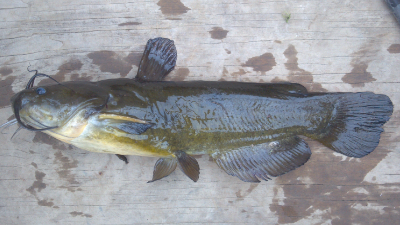
|
Bullhead catfish
Ameiurus spp.
Bullhead (Yellow bullhead pictured) are common throughout swamps, backwaters, ponds and lakes of Arkansas. They look similar to other catfish, except for a rounded tail fin and smaller maximum size, usually only reaching about 8 to 9 inches in length. They feed primarily on insects and benthic organisms and have a reputation for contributing to muddy water and negatively impacting sportfish populations in ponds. Bullhead should be avoided in fishing ponds if possible.
|
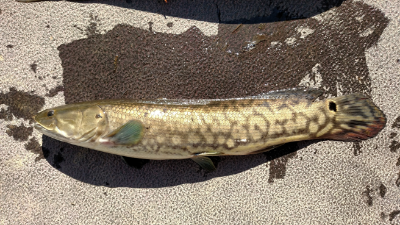
|
Bowfin
Amia calva
Bowfin are large predators usually found in vegetated backwaters, ponds and lakes, feeding primarily on fish and aquatic invertebrates. Bowfin are extremely exciting to catch on largemouth bass fishing gear for their aggressive fighting style. Still, bowfin are considered a nuisance because they don’t usually get abundant enough to support regular fishing but they do compete directly with largemouth bass for food.
|
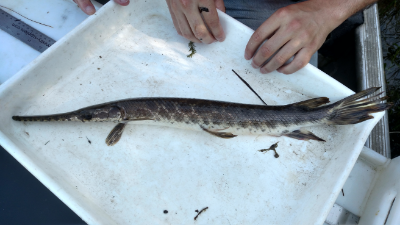
|
Gar
Lepisosteus spp.
Gar are large predators of fish that usually inhabit shallow calm backwaters, ponds and lakes. They are easily identified by their long snouts and sharp teeth. While gar will eat any species of fish small enough for them to swallow whole, their impact on fish communities is often exaggerated. Nevertheless, gar are considered a nuisance in ponds because they compete for food with more desirable species, and should be avoided if possible.
|